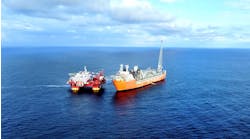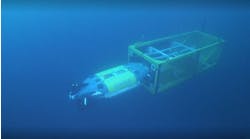Nick Terdre
Contributing Editor
ABB Anchor Contracting's riser support system provides a competitive solution for riser support in both conventional and deepwater. The system has been installed on both Statoil's Åsgard and Esso Norge's Ringhorne developments in the Norwegian sector of the North Sea.
A mid-water arch (MWA) that is typically installed 70-100 m from the seabed provides riser support. Connecting the risers to the MWA largely eliminates the dynamic forces that would otherwise cause friction and fatigue.
A high-capacity subsea buoy is the heart of ABB's system. This is a steel buoyancy tank that contains pressurized compartments that equalize the internal buoy pressure and ambient water pressure.
The larger of two mid-water arches supplied by ABB Anchor Contracting to Statoil's Åsgard B development has a net buoyancy in water of 400 metric tons.
null
In the case of the larger of two MWAs supplied for the Åsgard B development, the cylinder-shaped tank measures 28 m in length by 5 m in diameter and has a net buoyancy capacity in water of 400 tons. The other Åsgard B MWA has a net buoyancy of 250 tons. Installed in 2000, the two MWAs support nine risers in 300 m water depth. Tethers attached to anchors at the seabed hold the MWA in place.
In the case of deepwater applications, the MWA can accommodate hybrid riser systems. Steel catenary risers are installed between the seabed and the subsea buoy located 150-200 m below the surface. At the buoy, which takes the hang-off load, the risers are connected to flexible risers hung from the surface vessel.
This solution is proving of interest to deep-water operators, as it achieves competitive costs through a design that allows for efficient transport and installation of such systems, the components of which are considerably larger than those of conventional MWAs, according to marine manager JohnLassen-Urdahl.




